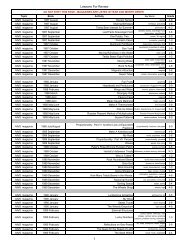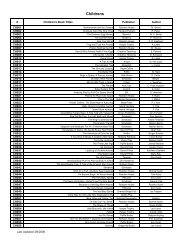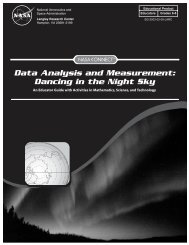Data Analysis & Measurement: Having a Solar Blast pdf - ER - NASA
Data Analysis & Measurement: Having a Solar Blast pdf - ER - NASA
Data Analysis & Measurement: Having a Solar Blast pdf - ER - NASA
Create successful ePaper yourself
Turn your PDF publications into a flip-book with our unique Google optimized e-Paper software.
6<br />
2001-2002 <strong>NASA</strong> CONNECT Series<br />
Hands-On Activity<br />
BACKGROUND<br />
The Sun is the nearest star to Earth and our<br />
proximity to it allows us to study it in great detail.<br />
Observations reveal that the Sun is extremely<br />
dynamic, with changes taking place on many<br />
timescales. <strong>Solar</strong> flares are among the fastest and<br />
most energetic events on the Sun.<br />
<strong>Solar</strong> flares are the biggest explosions in the solar<br />
system! A solar flare occurs when magnetic energy<br />
that builds up in the solar atmosphere is suddenly<br />
released. Charged particles, such as electrons,<br />
protons, and heavier ions, are accelerated to such<br />
high energies that some are traveling at almost the<br />
speed of light. Some of these charged particles<br />
travel away from the Sun along magnetic field lines.<br />
Others move towards the surface of the Sun and<br />
emit X-rays and gamma rays as they slow down.<br />
Also, gas in the solar atmosphere is heated to<br />
temperatures as high as 100 million degrees Celsius.<br />
This heated gas emits X-rays as well. Flares produce<br />
all forms of electromagnetic radiation from radio<br />
waves and visible light to X-rays and gamma rays.<br />
<strong>Solar</strong> Flares occur in the solar atmosphere. The solar<br />
atmosphere starts at the photosphere, where the<br />
visible light from the Sun originates. It extends<br />
through the intermediate layer called the<br />
chromosphere to the outermost layer called the<br />
corona. The gas in the corona normally has a<br />
temperature of a few million degrees. Inside a flare,<br />
the temperature typically reaches 10 to 20 million<br />
degrees and can be as high as 100 million degrees<br />
Celsius. The frequency of solar flares varies with the<br />
Sun’s 11-year cycle. When the solar cycle is at a<br />
minimum, very few flares occur. As the Sun<br />
approaches the maximum part of its cycle, they<br />
begin to occur more and more frequently.<br />
The biggest flares are as powerful as billions of<br />
hydrogen bombs exploding at the same time! We<br />
still don’t know what triggers them or how they<br />
release so much energy in such a short time. <strong>Solar</strong><br />
flares have a direct effect on the Earth’s upper<br />
atmosphere. For instance, long distance radio<br />
communications can be disrupted by the effect the<br />
flares have on the Earth’s ionosphere. In addition,<br />
energetic particles accelerated in solar flares that<br />
escape into interplanetary space are dangerous to<br />
astronauts outside the protection of the Earth’s<br />
magnetic field and to electronic instruments in<br />
space. Understanding solar flares can aid in<br />
understanding energetic events throughout the<br />
Universe.<br />
In the hands-on activity,“X-ray Candles: <strong>Solar</strong> Flares<br />
on Your Birthday”, students will discover the solar<br />
cycle through an investigation of solar X-ray flares.<br />
Using the Geostationary Operational Environmental<br />
Satellite (GOES) X-ray data, students will record the<br />
total number of solar flares in their birth month over<br />
11 years and will compute the percentage of high<br />
class flares which occur for each year. Students will<br />
graph their findings to help them identify the longterm<br />
pattern of flare activity on the Sun.<br />
NATIONAL STANDARDS<br />
Mathematics (NCTM) Standards<br />
• Understand numbers, ways of representing<br />
numbers, relationships among numbers, and<br />
number systems.<br />
• Compute fluently and make reasonable estimates.<br />
• Use mathematical models to represent and<br />
understand quantitative relationships.<br />
• Apply appropriate techniques, tools, and formulas<br />
to determine measurements.<br />
• Formulate questions that can be addressed with<br />
data and collect, organize, and display relevant<br />
data to answer them.<br />
• Develop and evaluate inferences and predictions<br />
that are based on data.<br />
• Build new mathematical knowledge through<br />
problem solving.<br />
• Communicate mathematical thinking coherently<br />
and clearly to peers, teachers, and others.<br />
• Create and use representations to organize, record,<br />
and communicate mathematical ideas.<br />
<strong>Data</strong> <strong>Analysis</strong> and <strong>Measurement</strong>: <strong>Having</strong> a <strong>Solar</strong> <strong>Blast</strong>!<br />
EG-2002-01-01-LARC
















